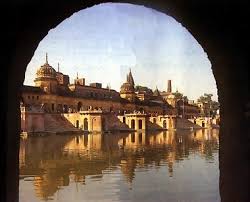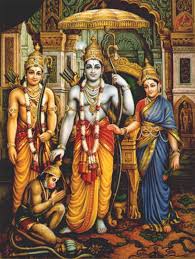Sahasranama tattulyam rama namam varanane ||
Aapadamapahartaram dataram sarvasampatam |
Lokabi ramam sriramam bhuyo bhuyo namayaham ||
In the innumerable avatars of the Lord, Sri Rama Avatar is poornam or total. It is unique avatar. He was born and brought uo at one place, had only one father-mother, one wife and always maintained one word [never changed His word], maintained honest living for His subjects, sages, hunters, monkeys and even rakshasas. Sri Ramachandra, worshiped all over Bharat, was born in Ayodhya. Keeping Sri Rama as the example, Sri Krishna delivered Gita Shastra! Gita can be taken as Sri Rama's life history. He set Himself as example as to how a person has to live, whom He should respect, where He should not show his anger, where honesty was to be maintained, etc. Sri Rama's life history was written by Valmiki as Srimad Ramayanam, which is special among the Two Itihasa. Sri Rama's good qualities could be seen at many places in Srimad Ramayanam. An old sloka summarizing them says that even monkeys would help an honest person; but even own brother would desert dishonest person! Because Sri Rama was honest, monkeys helped Him. When Ravana followed wrong methods, his brother Vibheeshana deserted him. Therefore, we have to follow Sri Rama. That is why, we have now come to Ayodhya, birth place of Sri Rama. From today [7th August 2009], we will be visiting for some days, many important spots in this place and enjoy studying Gita!


Like these there are many gopurams, in North Indian architecture. Right after Andhra Pradesh, we can see like these tall gopurams in Madhya Pradesh, Uttar Pradesh, Bihar, Haryana, Orissa, Rajasthan, etc.

First, we will worship Sri Rama, Who can be seen everywhere in the city! With Sri Rama at the center and with Sri Sita and Lakshmana on His sides and with Anjaneya near by, He could be seen gracing us wherever we go in the city. Ayodhya is also known as Saket, Koshal, Uttar Koshal, etc. Ayodhya means unable to fight - yodhya asakhyam iti ayodhya. Can not be wrecked; can never be invaded. Ayodhya aparajita - Ayodhya can not be won. In Sri Vaikuntam also known as Saket, the capital city is called Ayodhya. The Lord gave it to Brahma, His son. From Brahma, steadily it changed hands and reached Swayambu Manu. During creation, Brahma created Swayambu Manu. One of his successors, established, on the South of Sarayu river, Ayodhya city, with 12 yojana [a type of measurement] length and breadth. Thus a part of Sri Vaikuntam was constructed South of Sarayu. That is why Ayodhya is First among the Seven Mukti yielding Kshetrams - Ayodhya, Mathura, Maya, Kashi, Kanchi, Avantika and Dwarika. In North, importance is not only given to the temple, but to the entire Kshetram, its Earth and river are considered sacred. Many do parikrama [going around chanting Lord's names] of the place. We had seen such parikrama of Govardhana hills, during Brindavan visit. Here, Two parikramas are observed. One is going around entire city outskirts, nearly Nine miles. The other is internally, going around places, which may be about Six miles. Kulasekara Alwar describes the beauty of this city in one of his pasurams in Perumal Tirumozhi. He yearns to see Lord Sri Rama in Ayodhya. He says Sri Rama was born to illuminate Surya dynasty! In Chapter 4 of Bhagavd Gita, at the beginning, the Lord mentions that much, much before Arjuna, the Lord preached Gita to others. He told Arjuna that in the beginning He told Vivaswan [Sun god]; Vivaswan told Manu, his son; Manu preached to his son Ikshvaku and thus flowed down. Thus, the Lord established the antiquity or ancientness of Karma yoga [sloka 4.1]. Sri Rama ruled Ayodhya about 35 generations after Ikshvaku, who ruled entire Bharat from Himalayas to Sethu! Valmiki, while praising Ayodhya, says that no illiterate could be seen in Ayodhya, no atheist and no liar! Tamil Poet Kamba in his Ramayanam epic says that one could not locate any shop selling locks and keys, as there was no demand for them! There was no thief in this city! There was no donor, as there was no person seeking alms! Ayodhya is part of Koshal desh. Because Sri Rama was born, it is very sacred to all. Now, we will see sloka 11 of Chapter 18:
na hi dehabhṛtā śakyaṃ tyaktuṃ karmāṇy aśeṣataḥ
yas tu karmaphalatyāgī sa tyāgīty abhidhīyate 18.11
He is praised as Tyagi. While discussing who was Tyagi and who was Sanyasi, Sri Krishna maintains that Tyagi and Sanyasi were one and the same and he who sacrificed the results of karmas, was Tyagi. He, who performs all karmas as aradhanam [worship] to the Lord and does not aspire for any result, is Tyagi. Dehabhrt = supporter of body or atman, na sakyam = can not, asesata = without leaving any, karmany = all actions, tyaktum = to be abandoned. That is, no atman with a body supported [ie. any living person], can ever remain without doing any action. Earlier we had seen that not even one moment, a person can remain without doing some action [sloka 3.5, BG 3.5]. Even without our knowledge we will be doing some action. Perhaps, without a body, atman alone might not do anything; but as long as there is a body, none can remain without doing any karma. The Lord therefore, cautions Arjuna that he can not abandon karma, when Arjuna doubted whether abandoning karma altogether was tyaga. Sri Krishna clarifies again that karmas can never be abandoned as body is there. But then, there is this Upanishad saying: 'na karmanana prajayat anena tyagenaike amrutatvamanavasu:' - only by tyaga, moksham could be reached. What about this? This is replied by Sri Krishna in the latter part of the sloka. Ya tu = who, karma phala = results of actions, tyagi = sacrifices, sa = he is, abhidhiyate = commended as, tyagi =Tyagi. Therefore, he who sacrifices or does not aspire, the results of karma, and not abandon the karmas totally, is Tyagi and this is the interpretation for the Upanishad's saying also. By sacrificing the results of karmas, one reaches Moksham. Sri Rama never aspired for any result and performed His duty of protecting His people as main objective. Let us follow Sri Rama and explore more in Ayodhya.
No comments:
Post a Comment